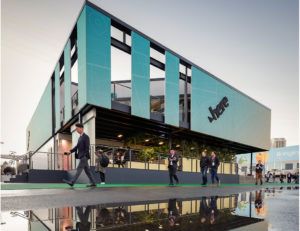Jack Blog
January 18th, 2023
 Jack leaders weigh in on the big themes from the show and provide observations on the show’s evolution, what’s working, and what’s not.
Jack leaders weigh in on the big themes from the show and provide observations on the show’s evolution, what’s working, and what’s not.
“CES is back, and it is all about an even larger ecosystem.”
Ed Scott, President, US
As I walked the floor at CES ’23 the first thing that struck me was the energy. While it didn’t feel like the numbers had returned to pre-pandemic levels, the excitement had. It was palpable. The lines were long, giveaways spilled out of bags, and in terms of brands, most of the usual (and a few unusual) suspects showed up.
What surprised me the most was the ubiquity of vehicles and the proximity of a future of mobility. It has been 15 years since CES welcomed its first automaker. Since then, that number has exploded. New verticals such as autonomous buses are prevalent, and the stalwart exhibitors have incorporated mobility into their ecosystem story. As these brands tell a story of how they will be the center of a simpler, safer, more environmental, and comfortable future, they finally recognize the importance of brand-to-brand partnerships. Closed systems won’t cut it.
Experience take-away: Think about the role partnerships play in your ecosystem
“Talking about sustainability is good. Doing it is better.”
Julien Le Bas, SVP, Executive Creative Director
With climate change’s adverse effects omnipresent along with the growing need for inclusivity and equity, many brands are providing sustainable products and solutions that leverage technology for better, simpler, and healthier living.
This welcome trend was visible at CES ‘23, with brands creating ingenious displays and immersive experiences promoting sustainable innovations.
Yet a stroll through the show revealed that once again, a large part of the exhibits and floor carpet will end up in waste containers to be, at best, recycled, at worst, landfilled. This uneasy feeling was reinforced by constantly illuminated flood lights running on humming generators, and ever-on gas heaters dispatched around the show.
This contradiction doesn’t have to exist.
It is time for CES and its exhibitors to move a step closer, stop separating products from communication efforts, and embrace sustainability as an output and a process. After all, some brands have already paved the way by demonstrating that creating sustainable solutions and communicating about them can be reconciled without compromise using smart design, clever operations, and questioning the status quo.
Better, simpler, and healthier living requires this gap to be closed through awareness, new practices, and innovations.
Experience take-away: Sustainability must be baked into every audience touchpoint.
“Digital transformation is key to a better health future that works for all.”
Jamey Hardesty, MPH, SVP, Senior Director of Strategy, Jack Health
In recent years, technology has become part of our daily lives at work and home to drive improved health outcomes. Speakers across CES’ Digital Health track put forward the promise of digital transformation and how we’ll get there. A key theme was health inequity and how it creates barriers to tech use, such as socio-economic status, race/ethnicity, where you live (rural care), age, and health data security and privacy concerns.
Bridging that gap are technologies you’ve likely already used, even if you weren’t aware, like artificial intelligence. Another is the emergence of new models of care, like telemedicine, at-home care, and retail care, which are providing new proof points for what will ultimately be a new care system architecture that moves us from sick care to preventative and pre-symptomatic care.
We have a long road ahead yet to realize the potential of the preponderance of health data out there today. Still, one thing is for sure; it will take close collaboration between public and private ventures, including Big Tech and health insurance companies and systems, to fully realize a better health future that works for all.
Experience take-away: Solutions that address health inequities are a win-win for the industry and the community